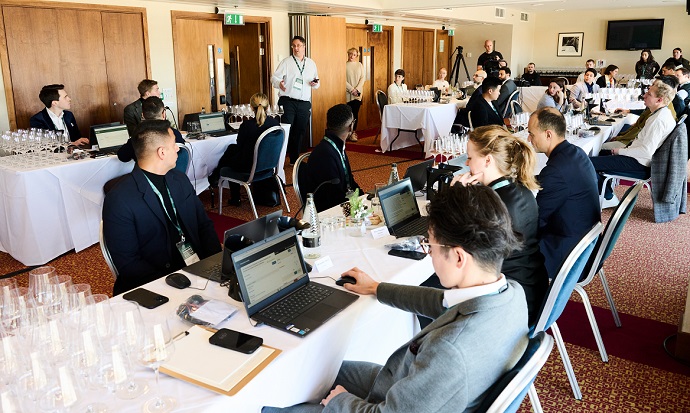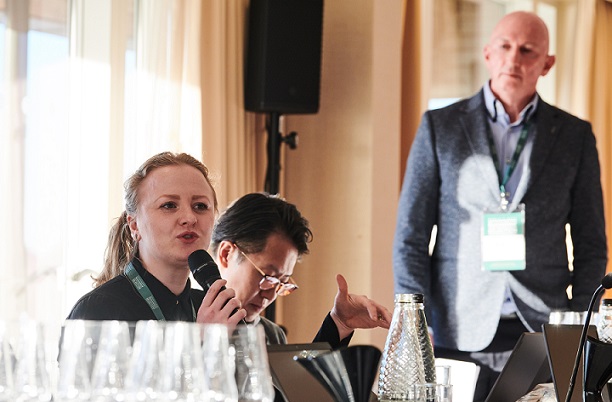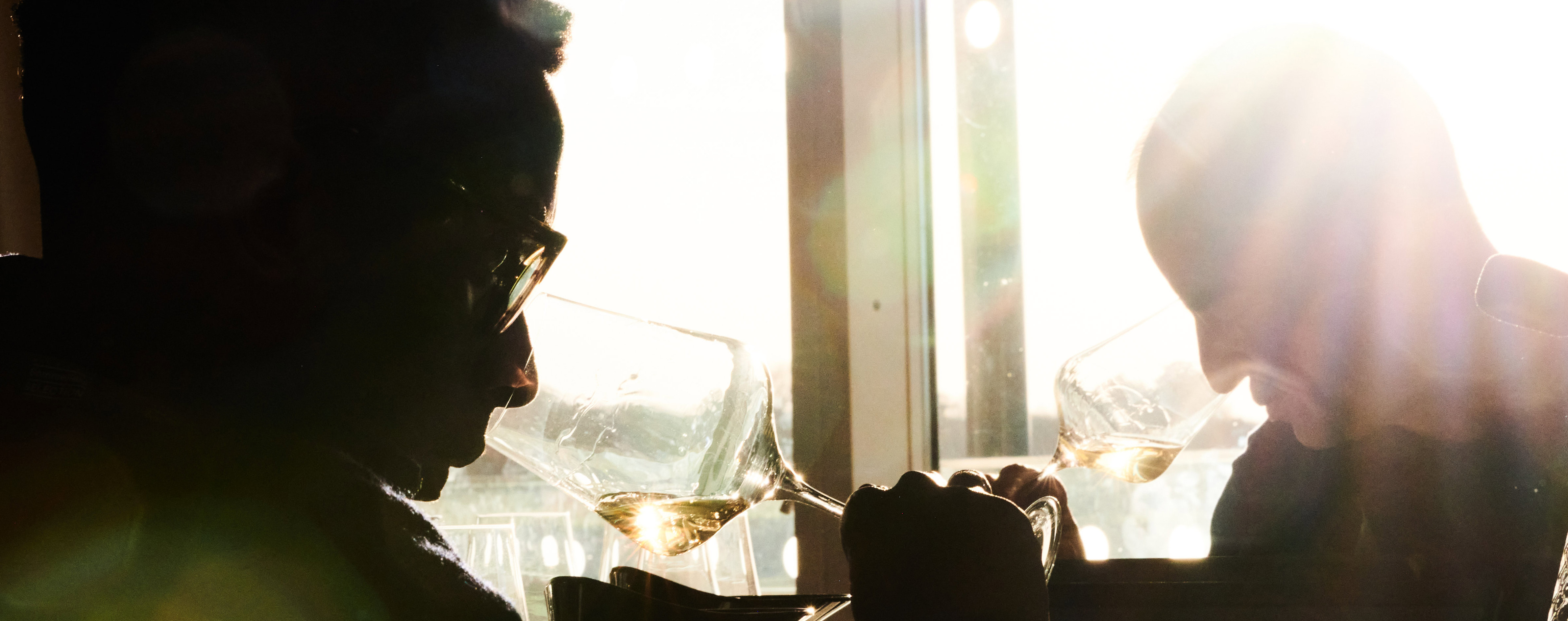Amanda Wassmer-Bulgin, sommelier and co-owner of Swiss restaurant Memories, is addressing a group of 30 renowned sommeliers.

They have gathered at Lingfield Park Racecourse in Surrey, England, for the first World’s Best Sommeliers’ Selection – a wine list that will serve as a useful tool for on-trade professionals seeking inspiration or peer-recommended wines.
Halfway through the event, Canopy hosted a roundtable discussion with the sommeliers, most of whom are from destinations in the 50 Best Restaurants list, which is part of the same stable of brands as Canopy and World’s Best Vineyards.
The wide-ranging discussion included grumbles about the prices and allocations of top Burgundies and Champagnes and some of the most unusual pairings*. But it also included some advice for wine producers about what makes a fine wine, how to get listed in a top restaurant and the importance of eco-credentials.
‘Fine wine is so much more than what’s in the glass’
What’s a fine wine?

Amanda Wassmer-Bulgin (above) kicked off the debate by referencing the Define Fine Wine white paper from the international thinktank Fine Minds 4 Fine Wines, organised by Areni Global.
The paper says: “A Fine Wine is complex, balanced, with a potential to age – though highly drinkable at every stage of its development. A wine that provokes emotions and wonders to the one drinking it, while reflecting the expression of truth intended by its maker and which is sustainably produced.
“Like a work of art, Fine Wine is also a cultural object, that links people and places, past and future… Like great art, we know a Fine Wine when we see it.”
Amanda then added her own opinion: “I do think that a fine wine needs to evoke something. A lot of the wines I was tasting up to now are really solid wines, but I need a little more emotion… I think, for me, this is what fine wine is about. We can’t forget we’re not doctors, we’re not working for NASA, we’re celebrating something really pleasurable. And I think fine wine should be more than just tasting it analytically. Being able to judge quality is important, but I think the story is important. What are they doing for the community?
“I think that fine wine is so much more than what’s in the glass. And that’s why I think tastings like this are actually quite interesting, because it’s not blind, because you are seeing and I think this is fine. Wine is about emotions of a story and, moving forward, I hope that wine is seen as more than just a commodity.”

Jhonel Faelnar (above), beverage director at Atomix in New York, pointed out that sommeliers are partly responsible for defining a fine wine. Once a wine is listed in a fine-dining establishment, it is seen as a fine wine. He explained: “Whether or not we like it – and hopefully we do enjoy that responsibility – we are kind of choosing what the next generation of drinkers and also the current generation of drinkers are paying attention to. Because it’s on our wine list and we have that aura.”
But Nina Højgaard Jensen (below), sommelier at Alchemist in Copenhagen, Denmark, cautioned: “We must be rational in our approach… because wine can sometimes be put up on this pedestal, which I don’t believe it was ever intended to be on.”

What’s your advice for a wine producer who wants to get on the wine list in a top restaurant?
Jonathan Kleeman, group beverage manager and executive head sommelier at Story Group (Story, Story Cellar, and Dovetail in London), offered this advice to wine producers: “Don’t have your wines available for a similar price with retailers as you would sell it to us… I have producers that I work with that I have exclusivity with in the UK, so nobody else has the wine.”Laure Patry of London-based Wine Source Group agreed: “Make sure your wine is not everywhere and you focus on restaurants.” But she added this tip: “Visit the restaurant.” This is so you can develop a relationship with the sommeliers, who have less and less time to travel and visit wineries.
How important are sustainability credentials?
Amanda Wassmer-Bulgin also led the discussion on the increasingly important topic of sustainability. She told her colleagues: “We’re gatekeepers, we have a responsibility… A responsibility to ensure that the wines that we list are economically and environmentally sustainable… I really feel that our duty is to make sure we don’t have to announce that all the wines on our list are sustainable, but I think that before the wines even get to our list, we have a duty to question how’s it being made? Because I think we can push people to produce wines using regenerative farming, but only if we request that. Imagine if all the top restaurants said, ‘No, I don’t want that herbicide anywhere near my products’. We could make a change as a unit.”Jonathan Kleeman added: “It’s not just about the vineyards with their practices, it’s about packaging, it’s about how they’re transported… I’m open to change, open to lots of different packaging now, including lighter glass.”
Highlights from the first World’s Best Sommeliers’ Selection
What producers said about this new event
The World’s Best Sommeliers’ Selection, compiled by sommeliers from four continents and 16 countries, will be released this month. Mireia Pujol-Busquets from Spanish winery Alta Alella, whose cava is included in the inaugural list, said: “I was thrilled to have the opportunity to present my cava to such an acclaimed group of sommeliers. It is incredibly important to get my wine in front of such influential decision-makers, and to ensure it is part of relevant discussions within the industry. The event gave me the chance for a real evaluation of my cava by people with immense knowledge and experience who were able to assess it against other exceptional wines.”
Stefan Doktor from Schloss Johannisberg in Germany, whose Riesling was also selected by the sommeliers, added: “We found the event extremely rewarding because we were able to showcase our wine in a really meaningful way and give a detailed account of the narrative behind the bottle. This allowed us to do justice to all the work that is done at the winery and present our wine in context. We are delighted to have a place in the selection and pleased to have had the opportunity to share our wine with such a highly regarded global community of sommeliers.”
Lucas Barinc from Mahsarto d’Midin in the Şırnak region of Turkey commented: “Turkish wine is a real niche offering, so we were delighted to have the opportunity to get our wine in front of sommeliers of such a high calibre. Each of the sommeliers represents different cultures and different styles of food, which gave us a real insight into where our wine sits from a gastronomic perspective. We’re thrilled to have been selected and look forward to sharing our wine with sommeliers around the world.”
The complete World’s Best Sommeliers’ Selection 2024 will soon be available here, accompanied by the sommeliers’ extensive tasting notes and food pairing recommendations. worldsbestsommeliersselection.com provides sommeliers from all over the world with a site to source interesting wines for their wine list in the knowledge that they have been specially selected by their peers. The website also offers the unique functionality of being able to search for wines based on factors such as high altitude, cool climate, old vines, oak-aged or by food pairings.
*The group’s unusual pairings put Marsala with lentils or a lukewarm radish salad and Madeira with onion soup. Their inspiring pairings also put sake with lobster, rare Mallorcan grape Callet with a vegan sausage dish and an orange wine from Greece (Sclavos Orange Muscat) with a duck curry. For more information on these pairings, visit our sister website 50 Best.

 English
English French
French







.png)


